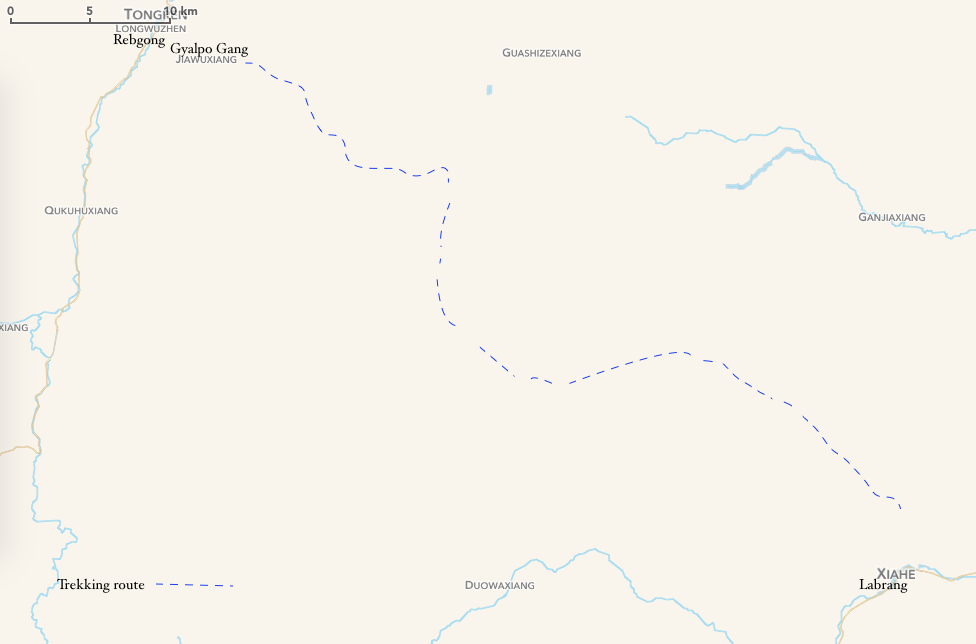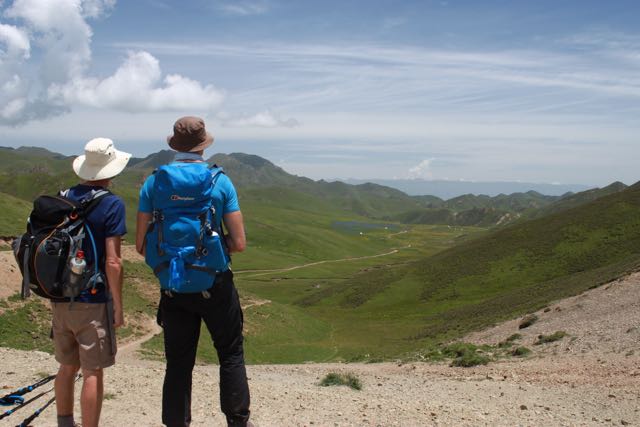|
Tour Info Destination: Amdo, Qinghai, Gansu, province, China Best season to visit: June-early September. Trip length: 13-days Trekking: 4 Days Road trip: 8 days Camping: 4 nights Homestay: 1 night Hotel: 7 nights Trip type: cultural, nature, and trekking Means of transportation: 4X4 Car or minibus 🌡 ☪ 3~10°c ☀️ 5~15°c
|
Trip at a glance Day01 :Xining- drive to Karothang village🛬 Day02 Shakhyung Gonpa-Rebgong Day03: Rebkong Day04.Trekking starts Day05. Luchu Thang. Day06. Gomang Sakyi Day07. Ruthang Day08. Labrang Day09. Labrang Day10. Taktsang lhamo (Langmusi) Day11. Sogdzong(Henan Xian) Day12. Xining Day13 Departure.🛫 |
Highlights:
On this trekking trip, you will learn a lot about Tibetan culture, spirits, customs, history, different schools of Buddhism, and the way of living of ordinary people on both pastureland and the agricultural area of Amdo Tibet.
Day01.Xining Arrival in Xining airport from the major cities like Beijing, Shanghai, or Chengdu at 15:00. We meet you at the airport and transfer to the hotel or we can drive to Karothang; a Tibetan village and stay in a Tibetan home for the night.
Day02 Shakhyung Gonpa-Rebgong. Drive (about 9:00 am)to Shakhyung Gonpa (Garuda) monastery, located on a Garuda-shape mountain with down looking sharp cliff on one side. From the top of the cliff, you can have a spectacular view of the bands of Ma-chu (Yellow river). It’s one of the four principal Gelugpa (schools) monasteries in north Amdo as well as a major pilgrimage site for Tibetans, founded by ChosGyal Dondup Rinchen; the Great Master of Tsongkhapa(50km). After visiting Shakhyung Gonpa, we will drive to Rebkong. Hotel.
Day03: Rebkong The valleys of Repkong is home to the renowned school of Rebkong Art, one of the most highly esteemed traditions of Buddhist painting and sculpture in the Tibetan world. At the farming villages of Sengeshong Yagotsang on the east bank of the Gu-Chu river, you will visit exquisitely decorated temples and the studios of the villages and monastic artists where painted scrolls can be purchased. Most of the temples and monasteries of Amdo, which have been reconstructed in recent years, have commissioned works of art, including elaborated mural panels, from Repkong. In town, this afternoon, you explore the vast complex of Rongpo Gonchen, originally a Sakya Foundation (1301) which was reconstituted as a Gelukpa monastery in the 16th century, and then you drive north along the west bank of the Guchu to visit Nyentok Gonpa. At Nyentok the most impressive building is the Jamkhang- containing a 13m Maitreya, while at Gomar there is a seven-tiered stupa with multiple chapels dedicated to the meditational deities of the four classes of the tantra. Around 5:30 pm monks gather in their debate courtyard and you will see the debating course. Hotel in Rebkong
Day04.Trekking starts You will start trekking from a Tibetan village called Gyalpo Gang. The valley of Gyalpo Gang is filled with Tibetan villages like terraces in the rice field. Their houses are built on earth and woods. People are very hospitable. Each village has a small temple in the center of their village and with a full atmosphere. This trekking route we have chosen was actually an old footpath used by pilgrims in the past. After passing the pass, you will be on beautiful pastureland and you will see yaks and sheep along with little houses of the shepherds. Camping on the grasslands.
Day05 Luchu Thang. Around 9:30 am. You will resume your trekking. There are Drogpas (people who live on live stocks) on your route so you may stop for some tea at their tents. There are several passes to pass but not a big pass. (approximately 3400m). You will see cairns on each pass. That indicates it’s the genuine pilgrim route in the past. Camping in Luchu Thang, near small villages.
Day06 Gomang Sakyi- Luchu’s summer pasture land (12KM / Proximately 5-6 hrs) In the morning about 9:30 am our Tibetan caravan serviceman will drive about 8km towards the southeast of Luchu Thang and then at the pass called Bonpo Nyaka and after leaving the main road, you will be dropped off. You will be again on your feet follow the footpath which leads to some Dropa(nomads) families and after 3 hours walking you will arrive on a pass called A Kyab Nyaka. (3820m). From the pass, you will have a gorges view of the distances mountains and valleys with diverse flowers. After saying ‘Ge ge so so lhagyaL lo” you will descend and walk through the valley. Camping at Gomang Sakyi.
Day07 Today- you will cross the regional borderline of Gyalpo Luchu and Ganja you will also cross a river several times and eventually you will arrive at the end of the valley and you will cross the river again to reach a wide-open grassland. Now you are on Ganja grassland and you will camp near a hill called Ruthang meaning the hill, has a formation of a snake, therefore, it is called the snake hill. You will end your trekking trip here.
Day08 Labrang- (Xiahe) This morning, after loading everything on the vehicle and you will drive to Labrang, about 40 minutes drive from the camping site. Check-in the hotel and rest for rest of the day.
Day09. Labrang- At 10:10 am. visit the Gonpa; Labrang Tashi Kyil monastery is somehow located near the frontier line and has become strategically an essential gateway to Tibet. It is also one of the several largest monasteries in Tibet and was founded by the first Jamyang Sherpa. There is a large community of monks in the monastery and they garter for assembling. You can see the monks debating in the late afternoon. The vibration of the monk's chanting can be felt as you approach the Sutra hall (the assembling hall). The printing house of Labrang is worth seeing.
Day10. Taktsang Lhamo. (Langmusi) Drive to Taktsang Lhamo and in the evening visit monks Debating in Kirti Gonpa (monastery). Visit also The tigers' nest located up in the valley near Kirti Gonpa.
Day11. Sogdzong(Henan Xian)- about a 60km drive along the Machu river, you will see a beautiful river band. After leaving the river on the left, you will head for north, very reach grassland, where some Mongolian tribs inhabit. en route, you will visit a huge cave called Lhamo Ne Khang. You may also visit a Gongpa(monastery) near the town of Sogdzong. Hotel.
EDay12 Xining- Drive to Xining, en route visit Lo Dorje Drag in Chentsa(Jian ca) county. Lo Dorje drag is a range of rocks on a hill. Its natural icons and formations are marvelous. There are also many caves for meditating
Day13 Departure.
What's included in this price?
- Private professional English-speaking tour guide.
- Private vehicle and Luggage Transfers.
- All necessary permits.
- All accommodations are based on double occupancy. Medium standard accommodation with attached bathroom on twin sharing basis or tent in remote areas.
- All Meals
- Admission fees.
- Service Charge (the planning, handling, operational, and communication charges) & government taxes.
- Tourists Accident/Casualty Insurance
- Crew members: cook.
- Equipment: Tents, mattress, kitchen staff.
What's excluded in the price?
- China visa, all air tickets.train tickets.
- Sightseeing is unlisted in the itinerary.
- Meals are not listed in the itinerary.
- Personal expenses such as laundry, drink, fax, telephone call, optional tour activities, etc.
- Gratuities, tips to guides, drivers, bellboys, etc.
- Excess Baggage Charges.
- Single room supplement.
- Sleeping bags
What’s Rebgong in Chinese?
It’s called HuangNan in Chinese. Sometimes it is also known as Tongren.
Where is it located and which provinces does it belong to?
It is located in the south of Xining, the capital of Qinghai province. It belongs to Qinghai provinces
What is Labrang in Chinese?
It is called Xia he in Chinese.
Where it is located and what province does it belong to?
it is located in the southeast of Rebgong and it is in Gansu province.
Are both Rebgong and Labrang culturally Tibetan areas?
Yes, both are truly Tibetan cultural areas.
How many hours walk each day?
Each day about 5-6 hours walk, depending on your speed
Do I need to bring my first aid with me?
Yes, recommended.
What’s Rebgong in Chinese?
It’s called HuangNan in Chinese. Sometimes it is also known as Tongren.
Where is it located and which provinces does it belong to?
It is located in the south of Xining, the capital of Qinghai province. It belongs to the Qinghai provinces
Do we need warmer clothes?
Wind jacket and Raincoat, thick soaks, and trekking boots are recommended. It gets cold during the night
Do we need to bring sleeping bags with us?
Because of the sizes, qualities, sanitation, etc, we recommend you bring it with you



